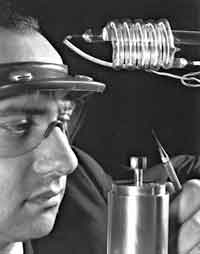Theodore H. Maiman
- Birthdate
- 1927/07/11
- Birthplace
- Los Angeles, CA, USA
- Death date
- 2007/05/05
- Associated organizations
- Korad Corporation, Hughes Aircraft Company, Maiman Associates
- Fields of study
- Photonics
- Awards
- Japan Prize
Biography
Theodore Maiman is famous for inventing the first functioning laser in the world in 1960. He has been called “the father of the electro-optics industry,” but Maiman considers himself a scientist and an engineer, with research interests in electro-optics, lasers, displays, and aerodynamics. In addition to his patent on the first working laser, the ruby laser, Maiman also holds patents on masers, laser displays, optical scanning, and laser modulation.
Maiman was born in 1927 in Los Angeles, California. Interested in technology at an early age, he worked for a time as a radio and appliance repairman. In part, Maiman’s later academic pursuits were inspired by his father, an electronics engineer and an inventor.
Maiman began his academic studies at the University of Colorado and earned a B.S. degree in engineering physics in 1949. Two years later he attended Stanford University and obtained a master’s degree in electrical engineering and then a doctorate in physics in 1955.
In 1960 Maiman invented the first functioning laser in the world while working at Hughes Aircraft Company. His invention was influenced by an article by Arthur L. Schawlow and Charles H. Townes, “Infrared and Optical Masers,” which appeared in The Physics Review in 1958. In their article the two scholars laid out a theoretical basis for the laser construction and outlined some of its problematic aspects. Maiman became the winner of the race to create the laser, which began in 1959. In addition to the work done at Hughes, other institutions such as Bell Labs, RCA Labs, Lincoln Labs, IBM, Westinghouse, and Siemens also engaged in the project. Maiman, after nine months of creative, yet hard and under-funded, labor succeeded first. The inventor himself explains the success by such factors as his favorable academic background (in electronics and optics), quest for simplicity, unconventional thinking, and a “maverick spirit.”
In 1962 Maiman established his own enterprise, Korad Corporation, which undertook the development and manufacture of lasers. In 1968, after selling the company to Union Carbide Corporation, Maiman founded Maiman Associates. He is currently a director of Control Laser Corporation and a member of the advisory board of Industrial Research Magazine.
Throughout his career, Maiman received many awards. He was twice nominated for the Nobel Prize and was given membership in both National Academies of Science and Engineers. He was also a recipient of 1983/1984 Physics Prize, the same year he was inducted into the National Inventors Hall of Fame. Three years later he became laureate of the prestigious Japan Prize, the Asian equivalent of the Nobel Prize.
Further Reading
